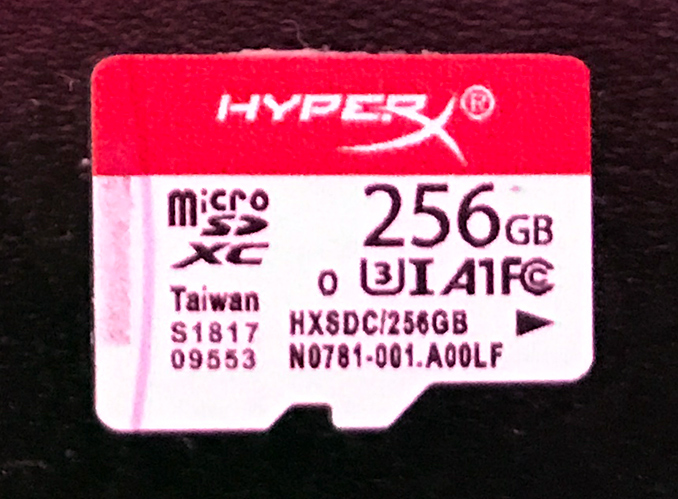Kingston Has HyperX 256 GB microSDXC Card for Gamers
by Anton Shilov on June 20, 2018 9:00 AM EST- Posted in
- Memory Cards
- Kingston
- HyperX
- Trade Shows
- microSDXC
- Computex 2018

In the recent years Kingston has repositioned its HyperX brand from performance enthusiasts to gamers, thus expanding the range from high-performance memory modules to a wide range of components and peripherals for PCs and even game consoles. As a part of its expansion, Kingston is about to add microSD memory cards into lineup.
Kingston’s initial family of HyperX microSD cards will be aimed at price-conscious gamers as well as owners of Nintendo Switch consoles that feature a UHS-I microSD card reader. Therefore, the HyperX microSD cards will be available in up to 256 GB capacities and will offer read/write speeds of up to 80 MB/s. This is slightly lower than 95 MB/s offered by some other UHS-I cards, but lower peak performance may also mean lower pricing.
Kingston showcased its 256 GB microSDXC HyperX card at Computex, its top-of-the-range offering. The card carries the Application Performance Class 1 (A1) and the U3 badges and thus provides a sustained performance of at least 30 MB/s, a performance of 1500 random read IOPS as well as 500 random write IOPS. Sustained performance of at least 30 MB/s along with ability to install applications on the card will ensure consistent user experience and will enable the microSDXC card to address smartphones used for gaming.
| Kingston HyperX 256 GB microSDXC Card Specs | ||||
| Sequential Write Speed | 80 MB/s | |||
| Sequential Read Speed | 80 MB/s | |||
| Sustained Speed | 30 MB/s | |||
| Random Performance | Read | 1500 IOPS | ||
| Write | 500 IOPS | |||
| NAND Type | 3D NAND | |||
| SDA Labels | A1, UHS-I, U3 | |||
Kingston’s HyperX microSD cards will hit the market this year. Prices are unknown, but expect them to be comparable to the company’s Canvas React cards that offer similar levels of performance and capabilities (up to 100 MB/s, U3, A1, V30).
| Want to keep up to date with all of our Computex 2018 Coverage? | ||||||
 Laptops |
 Hardware |
 Chips |
||||
| Follow AnandTech's breaking news here! | ||||||











4 Comments
View All Comments
vortexmak - Wednesday, June 20, 2018 - link
Such a confusing mish mash of labelsUHS-I , U3
What's the difference?
DanNeely - Wednesday, June 20, 2018 - link
UHS-1 is the interface protocol/generation, and sets the maximum data rate that the bus can support. U3/V30 are different generations of labelling that translate to a sustained sequential 30Mb/s write rate, which is the key criteria for video recording.A1 is an application performance class, which cares about random IO performance as well as sequential. In addition to the IOPS numbers in the table, A1 also requires U1/V10 level sustained sequential performance (10MBps) which this card's U3 rating (30MBps) will easily be able to exceed.
https://www.sdcard.org/developers/overview/speed_c...
https://www.androidpolice.com/2017/05/09/buyers-gu...
69369369 - Sunday, June 24, 2018 - link
inb4 paying 50% extra for gamer brandingLiKenun - Sunday, June 24, 2018 - link
Only UHS-Ⅰ? No UHS-Ⅱ? Only A1? No A2? I didn’t know gamers settled for so much less.